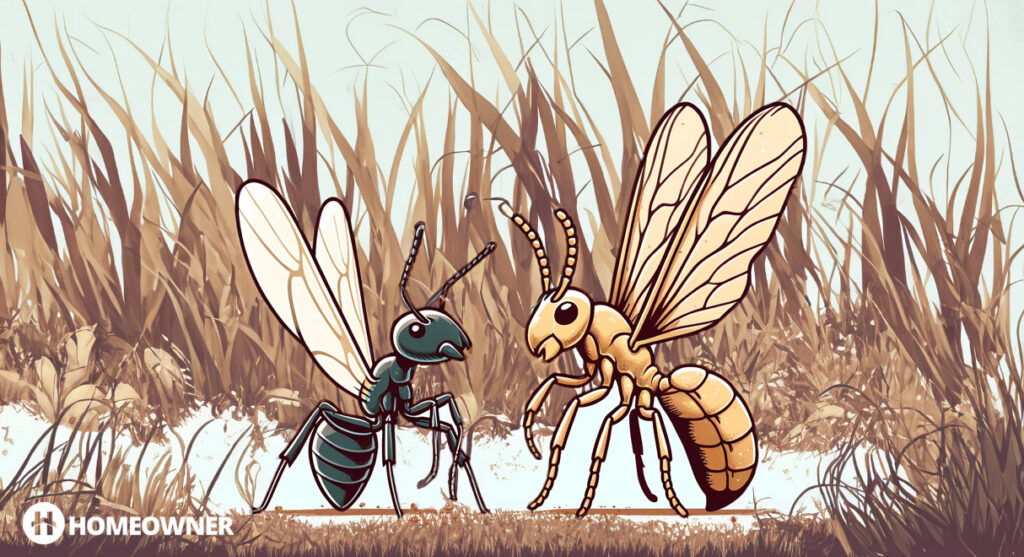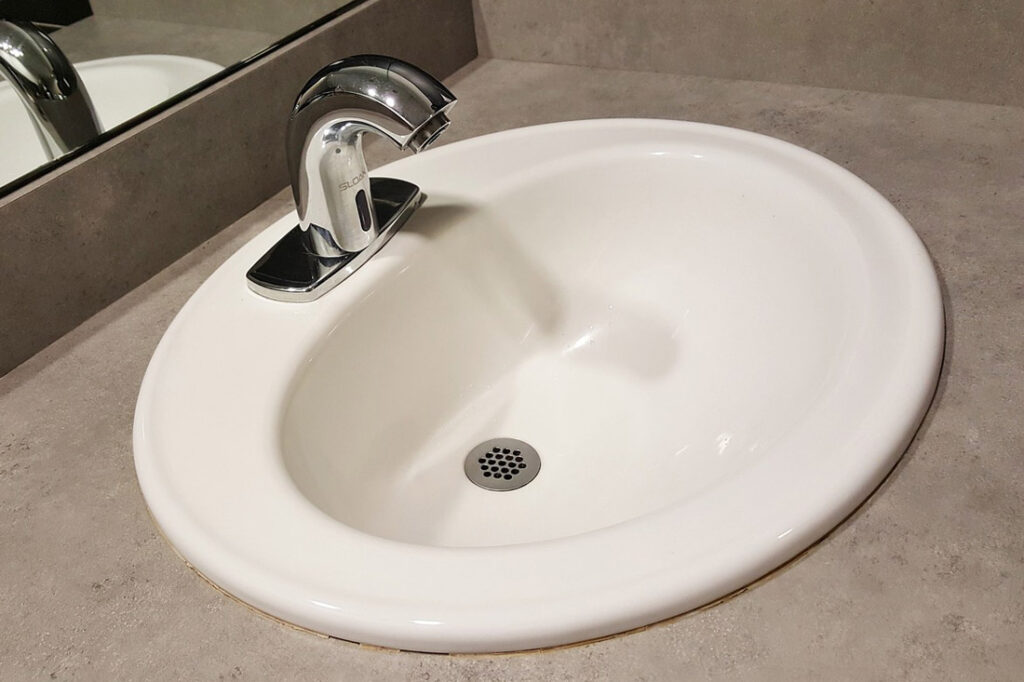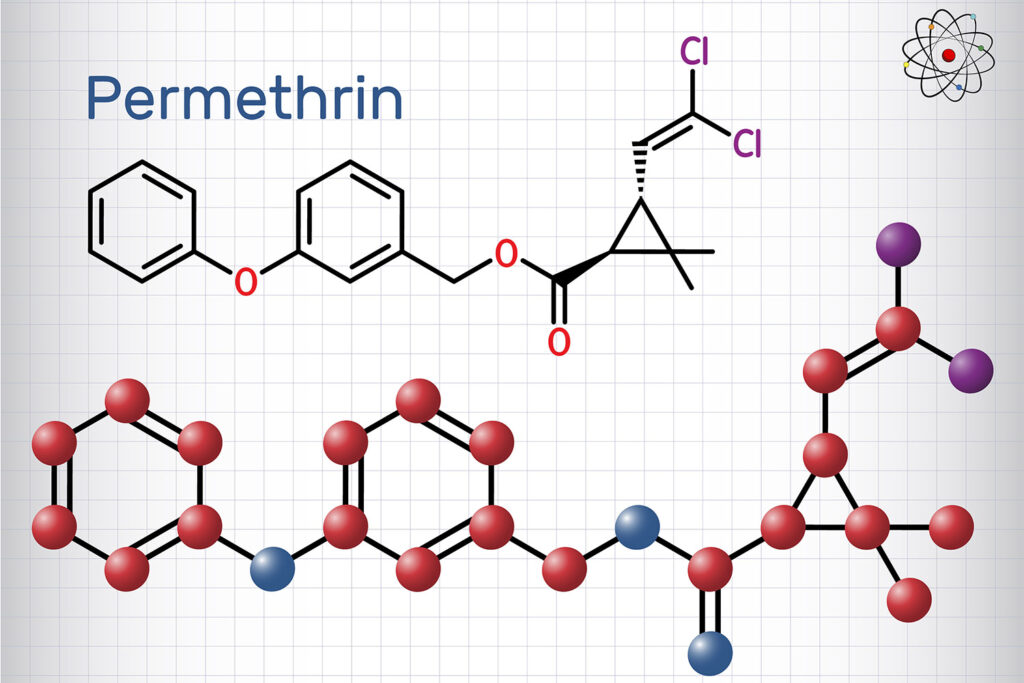Get Immediate Pest Control Help -
1-877-393-3401
Nobody wants pests in their house under any circumstances, but some are decidedly worse than others. Two of the most common that can put homeowners into quite a panic are flying ants and termites. Though these two pesky insects may look a lot alike to the untrained eye, they are quite different in terms of how you deal with them and the potential harm they can bring to the structure of your home.
Read on below to learn about the similarities and differences between them and find out the best pest control methods so you can continue enjoying your home without having to share it with uninvited guests.
👉 Suggested reading: How To Kill Termites.
What Is a Flying Ant?

All ants are social insects that tend to live in underground colonies (that can be both indoors and outdoors) or sometimes in trees. There are queen ants, worker ants, and winged ants (this is the type typically called a “flying ant” or an alate).
Get Immediate Pest Control Help -
1-877-393-3401
Alates are sexually mature ants who serve as “alternate reproductives” for the queen (or queens since there can be more than one in a colony) and are fed a special food by the worker ants that allow them to grow wings. When the existing ant colony becomes big enough and is ready to expand, the winged ants can then go on to establish their own colony. Flying ants are almost always black or brown in color.
These winged ants can be especially troublesome when they get into your home because it’s a sign that they’re ready to breed. This means if you don’t take care of them right away they can reproduce quickly and you’ll soon have even more ants to deal with.
What Is a Termite?

Termites are small insects that live in colonies that can range from just a few hundred to the tens and even hundreds of thousands. There are nearly 2,000 different termite species in the world, but only around 50 are found in the United States. Sometimes termites are referred to as “structural pests” because of the extensive damage they can inflict on homes and buildings, especially on structures made of wood since this (cellulose) is a major food source for them. Termites also eat other types of decaying plants, and they can also eat drywall, insulation, and other materials with cellulose used to build homes.
Termites tend to be pale yellow or tan in color, but some species can be brown or red.
Get Immediate Pest Control Help -
1-877-393-3401
There are three main types of termites: subterranean, Formosan (also subterranean), and drywood. The first two cause the most damage to living structures and can be the hardest for homeowners to deal with. Drywood termites can also cause damage, but typically not as extensive as the other kinds.
Differences Between Flying Ants and Termites
At first glance, a termite and a flying ant may seem very similar to homeowners who aren’t used to identifying these winged insects, but upon a closer look, there are several differences.
Appearance

One major difference in appearance between the two is that a flying ant has a pinched waist while a termite has a broad waist. The second big difference is in the shape of the antennae. A flying ant has bent, or elbowed, antennae while a termite has straight antennae. Finally, flying ants have two sets of wings that are different sizes and a termite’s set of wings are the same size as one another and are twice as long as its body. However, not all termites have wings so this isn’t the only defining characteristic, but the ones that do are called swarmers.
Behavior
Termites build mud tubes to get from their colony into your home and the presence of these can be a clear indication you have a termite infestation. These are typically found around the base of your home’s foundation or in the crawl space.Additionally, flying ants are often easier to spot because they don’t hide out the same way that termites do and are known to fly around in the open throughout the day.
Diet
Ants can feed on dead insect carcasses or food debris that’s been left in your kitchen, and termites live on cellulose which can be found in wood, drywall, cardboard, and insulation.
Habitat
Ants eat a variety of food while termites feed on wood, so their nesting sites will differ because of this. Ant colonies are typically found in humid places of your home or around food areas. Termite colonies, on the other hand, are found in decaying wood, the wood in your home, or in the ground below your home.
Life Span
Termites have a significantly longer lifespan than flying ants, with the average worker termite living for several years while a worker ant only lives for several months. A queen flying ant can live for 7 to 15 years while a queen termite can live as long as 50 years!
Damage Caused

Termites are much worse when it comes to the damage they can cause to a home, and addressing it can be expensive if you let it go on for too long. This is why calling a reputable pest control company is essential if you notice termite activity. Flying ants aren’t dangerous to you or your home, but they can definitely be a nuisance and should be addressed quickly so they don’t repopulate.
Similarities Between Flying Ants and Termites
For all the differences found between these two bothersome bugs, they do have a lot in common. Here are a few key similarities:
- Both can build their colonies underground and nest outside
- Both have two sets of wings and are similarly sized to one another
- Queens always outlive the worker insects by many years
- Some ants, like carpenter ants, can also set up colonies in wood
- Termites and flying ants have similar reproductive cycles in that both insects mate in the warmer months and lose their wings after mating
How To Tell If You Have Termites
You can start looking for termite activity by checking for mud tubes around your home or in your crawl space. You may also notice parts of the termite littered around like discarded wings or even termite carcasses.
For very severe infestations you may actually hear the termites crawling around or chewing through the wood in your home. Because termites eat the wood and other cellulose materials in your home, you’ll also want to look for signs of structural damage they’ve caused.
Here are some indications that you’re dealing with termite damage:
- Peeling paint or bumps under the paint can be an indication that termites are building tunnels in your walls
- Sagging or loose drywall
- Buckling or squeaky wood floors
- Loose floor tiles
- Small holes in the drywall
- Hollow sounding wood
How To Tell If You Have a Flying Ants
Flying ants are typically most prevalent in the spring months of April, May, and June when the weather starts warming up. They tend to enter homes through windows, doors, or cracks in the wall so you can look for activity and trails here. You can also look for discarded wings around these points. Keep an eye out for small mounds of excavated dirt around these entry points or in cracks and crevices that indicate a colony is living underneath.
If you notice a lot of flying ants in your home, it should be fairly clear that you’re dealing with an infestation and it’s not just a few stray insects that wandered into your home.
Tips for Preventing Flying Ants and Termites

The best way to prevent insects like flying ants and termites (or any insect really) is to have regular inspections performed by a reputable pest control company. This is especially true if you live in the southern part of the country where insect and termite activity tends to be much higher than in the north.
Here are some basic steps you can take to prevent infestations:
- Keep your kitchen clean and free of food debris which can attract flying ants.
- Cut back trees and shrubs from the sides and foundation of your house. Ideally, there should be at least an 18-inch gap between your home and any foliage.
- Don’t store firewood or compost bins directly next to your home. Ideally, firewood should be stored 20 feet away from your home and elevated at least five inches off the ground.
- Protect your crawlspaces and attics from excessive moisture and keep them well-ventilated.
- Clean gutters and downspouts regularly.
- Fix any leaks or holes in your home immediately.
- Ensure all your vents are clear and aren’t blocked.
- Perform regular inspections on your own.
- Consider purchasing a termite bond from a reputable pest control company. A termite bond is a contract with your exterminator to protect your home from termite infestations and damage.
How To Get Rid of Flying Ants
To effectively get rid of flying ants you must locate their nest and treat the area. This is best done by a professional pest control company because the nest can be difficult to locate.
If the infestation is not too severe, you can try to address this on your own by using insecticidal dust. You can also remove any visible ants by using a vacuum cleaner.
Some people like to use more natural remedies to destroy the nesting sites such as borax, essential oils, or diatomaceous earth, but these can have uneven results. If you find you can’t address the problem on your own, search for the best pest control companies in your area to have a professional come and take a look. Many of these companies provide free inspections.
How To Get Rid of Termites
Termites are one of the most destructive insects that plague homeowners and they’re also one of the hardest to get rid of. As a homeowner, you can try DIY methods like treating the ground around your home with a store-bought insecticide or using it directly on the wood that has been infested. You can also try using termite bait traps that can be set around your home. However, many homeowners find that these approaches simply aren't enough to keep termites away for good and must turn to a professional service.
A pest control company will use a variety of approaches including liquid or foam sprays, bait stations, and fumigation. The technician will treat both the soil around your home and the wood. Some companies like Terminix specialize in termite treatment and prevention. Most treatment packages come with follow-up inspections and retreatments as part of your total costs.
The Bottom Line

Whether you’re dealing with flying ants or termites, contacting a pest control company right away is usually your best course of action. This ensures the problem is handled right the first time, which is particularly important for termite infestations due to their destructive power.
Get Immediate Pest Control Help -
1-877-393-3401






